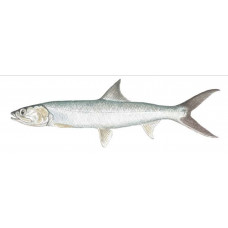Latin name
Elops saurus
Other names
Tenpounder, ubarana, malacho.
Identification
The ladyfish has an elongated, slender, silvery body with a blue-green back and fine scales. It looks very much like a juvenile tarpon, although it can be distinguished from a tarpon by the absence of an elongated last ray on its dorsal fin. The head is small and pointed, the mouth is terminal, and the tail is deeply forked. The body is oblong, low, almost circular in cross-section. The belly is smooth, without keel scales. The dorsal fin begins vertically from the middle of the body, its rays are soft, nonbranched, the beginning of the anal fin is far behind the dorsal fin. The pelvic fin is located under the anterior rays of the dorsal fin. The lateral line is straight, formed by simple (nonbranched) tubes. The eyes are large with a fat eyelid. Mouth large, almost terminal, lower jaw weakly mobile, weakly protruding forward. The maxillary bone extends far beyond the posterior margin of the eye. There is a plate between the outgrowths of the lower jaw. The scales are small.
Distribution
There is no consensus on the number of species belonging to the genus Elops, so data on the distribution are relative and can only characterize the peculiarities of the habitat of representatives in a particular region. There are data on the habitat of these fish in the Atlantic Ocean, from Bermuda to Rio de Janeiro, off the west and south coast of Africa. In the Indian Ocean, occurs in tropical waters. Occurs in the Pacific Ocean, in the Sea of Japan, from the Pacific coast of Japan (from Tokyo) south to the South China Sea, near the Hawaiian Islands.
Habitat
A gregarious pelagic fish. It inhabits both shelf and open waters, but is also capable of entering desalinated lagoons and bays. Ladyfish is a coastal species that prefers estuaries, mangroves, tidal pools, and channels. Sometimes occur on coral reefs.
Size
Some ladyfish can reach a weight of 15 to 24 pounds and a length of 3 feet. Such specimens are extremely rare, most commonly weighing between 2 and 3 pounds. The world record in tackle is a 6-pound specimen.
Life history and Behavior
These fish form large aggregations near the shore, spawning at sea. Their ribbon-like larvae are very similar to those of bonefish and tarpon.
Food and feeding habits
Adults feed mainly on fish and crustaceans. Shoals of ladyfish can often be seen chasing bait near the surface. In the Gulf of Mexico, shrimp are the main food items, followed by anchovy fish and small crabs.
Reproduction
The spawning runs in batches. In the Gulf of Mexico in December-March. The mature individuals move 20-30 miles offshore and spawn pelagic eggs. The larvae go through three distinctive periods of development. The first of these, the leptocephalus stage, lasts from the beginning of larval hatching, when the larva is about 5 mm long, to a body length of 45 mm. At this time, the body of the larva is ribbon-shaped, its head is small, and the teeth on its jaws are long and sharp and dagger-shaped. At 20 mm in length, the larva has already formed a tail fin. By the end of the first stage, the body begins to shorten (sometimes to 20 mm) and thicken, and by the end of the stage the shape of the head changes and dagger-like teeth disappear. During the third period, the larva begins to grow again and has dorsal, anal and pectoral fins, and is shaped like an adult fish. At 40-50 mm in length, the larvae return to coastal waters and develop in estuaries and bays, where there is a lot of underwater vegetation and water temperatures reach 25-30 °C.
| Classification | |
| Phylum | Chordata |
| Class | Actinopterygii |
| Squad | Elopiformes |
| Family | Elopidae |
| Genus | Elops |
| Species | E. saurus |
| Features | |
| Conservation status | Least Concern |
| Habitat | Pelagic |
| Life span, years | No information |
| Maximum body weight, kg | 10.1 |
| Maximum length, cm | 100 |
| Sailing speed, m/s | No information |
| Threat to people | Edible |
| Way of eating | Predator |
Ladyfish
Tags: Ladyfish





